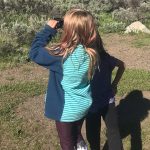
Follow these tips for your first birdwatching adventure.
Stay Close To Home
Stay close to home when just starting to birdwatch. Select a place nearby that you are familiar with. Birdwatching is a patience game, so keep your early experiences simple. Keep those first outings short (less than an hour), especially if you have young bird lovers with you.
Do Your Pre-Birding Research
Once you have chosen a location, do a quick internet search about that area. What is the habitat? Are there posts on social media or web pages from other birders with any information that can be helpful to you? The internet is a great resource for doing some pre-exploration of the birding site you will be visiting. If you know what to look for, you will be able to help hold young bird watchers keep interest.
Bring The Right Tools
Binoculars are the key tool for any bird watcher, both beginner and experienced. Before you head out to find some feathered friends, be sure you are familiar with how to use the binoculars. Having to fidget and mess with the binoculars on-site can cause movements and noise that may cause the birds to fly away. Bird-watching books and apps like Merlin Bird ID are also great tools to bring with you. You can even participate in citizen science by logging the birds you see for the Cornell Lab through the Merlin Bird ID app to help bird populations around the world. If you have young kids in tow, consider letting them bring a camera or journal they can use quietly while you patiently wait for a bird to come into view.
Patience And Silence Are A Virtue
When keeping a lookout for feathered friends, being quiet and patient are two key skills. Avoid making any sudden movements. Loud noises and quick actions will make a bird flee for cover. Whisper if you need to converse with anyone. Being patient and silent will allow you to get much closer to a bird, enhancing your bird-watching experience.
Use Your Senses
When trying to spot and identify birds, tap into your senses. What size is the bird? Does it have a particular shape, especially in the bill or beak? What color is it overall, and does it have any stand-out markings? Listen for the sounds the bird makes and watch for particular behaviors. The habitat it calls home can also help you identify the bird. Be sure to look up and look down as birds may not always be within your line of sight.
Keep The Bright Clothing At Home
Experienced bird watchers recommend that you avoid wearing bright colors, including white, when you are out spotting birds. Although birds don’t have amazing eyesight, they can see bright colors that they may confuse with movement. Neutral and natural colors that blend into the background are the safest bet.
Birds Of A Feather Flock Together
Sometimes it is helpful to follow the crowd. In this case, it refers to following the crowd of birds. If you see a large number of birds on a pond, head there quietly. If you see a large number of birds on particular trees, that is a good place to look. More than likely, you will see multiple types of birds gathered in one location.





